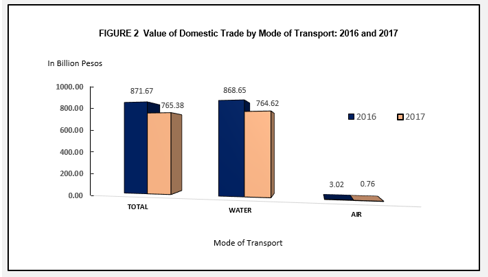Quantity and Value of domestic trade drop by 3.9 percent and 12.2 percent, respectively
The quantity of domestic trade in 2017 registered a total of 23.40 million tons, down by 3.9 percent from 24.35 million tons posted in 2016. Food and live animals commodities led in terms of quantity with 6.57 million tons (28.1%) of all the traded commodities while animal and vegetable oils, fats and waxes had the least with 0.11 million tons.

Similarly, total value of domestic trade decreased by 12.2 percent, from PHP871.67 billion in 2016 to PHP765.38 billion in 2017. Machinery and transport equipment posted the highest value of PHP269.99 billion. On the other hand, animal and vegetable oils, fats and waxes commodities was the lowest with a value of PHP6.01 billion.
By mode of transport, total value of traded commodities in 2017 through water transport accounted for 99.9% of the total commodities that flow in the country. The remaining 0.1% was through air transport.
Machinery and transport equipment account for 35.3 percent of total value of traded commodities
Among the commodities, machinery and transport equipment contributed the largest value amounting to PHP269.99 billion. Food and live animals with PHP172.96 billion or 22.6 percent share to total value and manufactured goods classified chiefly by material with PHP92.58 billion or 12.1 percent share placed second and third, respectively. Other traded commodities with their corresponding values in 2017 were the following:
• Mineral fuels, lubricants and related materials, PHP68.86 billion;
• Chemical and related products nec, PHP48.94 billion;
• Beverages and tobacco, PHP33.35 billion;
• Miscellaneous manufactured articles, PHP32.65 billion;
• Commodities and transactions nec, PHP22.59 billion;
• Crude materials, inedible, except fuels, PHP17.45 billion; and
• Animal and vegetable oils, fats and waxes, PHP6.00 billion.
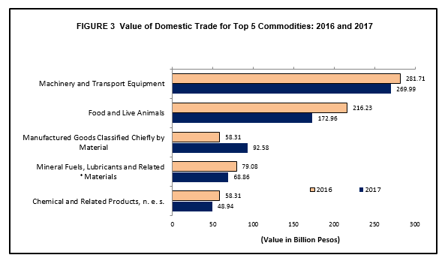
National Capital Region (NCR) accounts for 27.0 percent share to total trade value
Among the regions, NCR exhibited the largest share in trade value amounting to PHP206.40 billion or 27.0 percent of the total trade in 2017. Central Visayas followed with transactions amounting to PHP118.63 billion. Western Visayas with value amounting to PHP115.88 billion and Eastern Visayas, PHP97.72 billion, placed third and fourth, respectively. On the other hand, CALABARZON contributed the least share with only PHP845.02 million. Completing the list of regions with corresponding values in 2017 were the following:
• Northern Mindanao, PHP61.65 billion;
• Central Luzon, PHP50.33 billion;
• Caraga, PHP32.64 billion;
• Davao Region, PHP22.84 billion;
• Zamboanga Peninsula, PHP22.04 billion;
• Bicol Region, PHP13.29 billion;
• SOCCSKSARGEN, PHP10.86 billion;
• ARMM, PHP8.06 billion; and
• MIMAROPA Region, PHP4.19 billion.
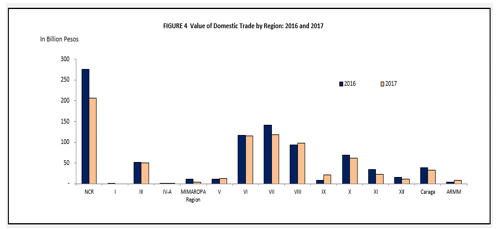
Note: No transactions for CAR and Region II
Value of total trade for commodities down by 12.2 percent
Outflow refers to the total quantity and value of commodities which go out from a specified region or province while Inflow refers to the total quantity and value of commodities that enter a specified region. Trade balance is the difference between the outflow and inflow.
Total outflow value in 2017 was registered at PHP765.38 billion, which indicated a drop of 12.2 percent from the 2016 outflow value of PHP871.67 billion. NCR posted the highest outflow value amounting to PHP206.40 billion or 27.0 percent of the total outflow in the country. It was followed by Central Visayas and Western Visayas with PHP118.63 billion and PHP115.88 billion, respectively. CALABARZON had the least outflow value with PHP845.02 million.
In terms of inflow value, Central Visayas recorded the biggest inflow value amounting to PHP138.13 billion in 2017. This translates to 18.0 percent share to total inflow value of all traded commodities. Cagayan Valley had the smallest inflow value of PHP111.32 million in 2017.

NCR posts positive trade balance of PHP115.58 billion
Out of the 16 regions, nine (9) regions showed unfavorable trade balance while seven (7) regions yielded positive trade balance. These were the following:
• NCR, PHP115.58 billion (the highest positive trade balance value);
• Central Luzon, PHP47.97 billion;
• Eastern Visayas, PHP39.11 billion;
• Bicol Region, PHP3.79 billion;
• SOCCSKSARGEN, PHP2.96 billion;
• ARMM, PHP2.30 billion; and
• Davao Region, PHP96.46 million.
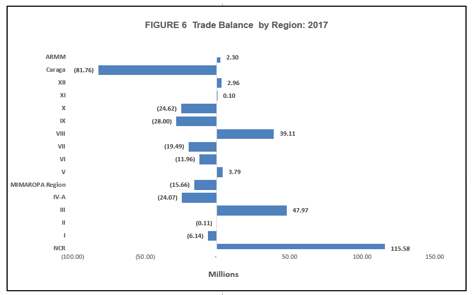
Note: No domestic transactions in CAR
Luzon group leads in terms of total domestic trade value
The Luzon group (NCR, CAR, Ilocos Region, Cagayan Valley, Central Luzon, CALABARZON, MIMAROPA Region and Bicol Region) topped in terms of domestic trade value in 2017 amounting to PHP261.76 billion or 34.2 percent of the total trade value in the country. It was followed by Mindanao Group (Zamboanga Peninsula, Northern Mindanao, Davao Region, SOCCSKSARGEN, Caraga and ARMM) with value of PHP255.85 billion and Visayas Group (Western Visayas, Central Visayas and Eastern Visayas) with PHP247.78 billion, respectively.
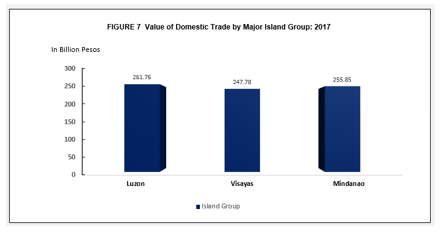
Most traded commodities in Luzon were machinery and transport equipment with total value of PHP61.22 billion or 23.4 percent share to total. It was followed by food and live animals with PHP51.84 billion or 19.8 percent and mineral fuels, lubricants and related materials with PHP49.11 billion or 18.8 percent.
The top three commodity sections in terms of their contribution to the total value of traded commodities in Visayas Group were the following: food and live animals (PHP77.37 billion or 31.2 percent), machinery and transport equipment (PHP59.31 billion or 23.9 percent), and manufactured goods classified chiefly by material (PHP35.51 billion or 14.3 percent).
In Mindanao Group, machinery and transport equipment recorded the highest domestic traded commodities worth PHP149.47 billion. This was followed by food and live animals and manufactured goods classified chiefly by material amounting to PHP43.75 billion and PHP21.85 billion, respectively.
Number of passengers rise by 29.1 percent
A total of 39.89 million passengers were transported via coastwise in 2017, an increase of 29.1 percent from the 30.90 million passengers in 2016. CALABARZON led the highest number of passengers of 16.40 million. Central Visayas and MIMAROPA Region, placed second and third with 5.69 million and 4.57 million passengers, respectively. Total number of passengers for the rest of the regions were:
• Western Visayas, 4.06 million;
• Bicol Region, 2.07 million;
• Eastern Visayas, 1.99 million;
• Northern Mindanao, 1.71 million;
• Zamboanga Peninsula, 1.28 million;
• Caraga, 1.24 million;
• NCR, 0.63 million; and
• ARMM, 0.27 million
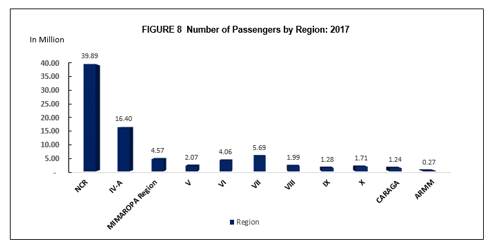
Note: No recorded number of passengers in CAR; and Regions I, II, III, XI and XII
EXPLANATORY NOTES
Introduction
This Special Release highlights the 2017 Annual Domestic Trade Statistics data on the movement of commodities from coastwise manifest and coastwise passenger manifest.
Copies of coastwise manifests are collected from the Philippine Port Authority while copies of air waybills are obtained from the Philippine Airlines. Coastwise manifests contain data on cargoes on board. These are from major ports and other active seaports listed by the PPA all over the country.
Data on the inflow and outflow of commodities in the different regions of the country are used to construct inter-regional and inter-industry relation tables.
The 1993 Philippine Standard Commodity Classification (PSCC) is used to classify the commodities at the 5-digit (item) for coastwise statistics, and 3-digit (group) for air statistics for statistical purposes.
Detailed data on domestic trade statistics are available at the Trade Statistics Division (TSD) - Economic Sector Statistics Service (ESSS) with Telephone Number: 376-19-75.
Limitations of Domestic Trade Data
The Domestic trade data in this report pertains to goods that passed through airports and seaports in the country, whether for government or private use, or for commercial purposes. Domestic trade through land is excluded because of the absence of an approach to capture data in the archipelagic island of the country. Moreover, data on rail transport is also excluded.
Air waybills, on the other hand, are collected only from the Philippine Airlines (PAL) which accounted for transactions that passes through all airports.
Goods and/or commodities that are excluded in the compilation of data are:
a. Goods transported by vessels of the Philippine Navy.
b. Fish and other marine products landed directly from the sea.
c. Service cargoes for consumption by vessel crew.
d. Cadaver
e. Vessels not carrying any cargo / passenger, wherein the vessel master indicates "NIL CARGO / PASSENGER" in the coasting / passenger manifests.
FOR THE OIC-DEPUTY NATIONAL STATISTICIAN:
WILMA A. GUILLEN
Assistant National Statistician, SSSS
Sectoral Statistics Office
(Officer-in-Charge)

